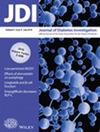Canagliflozin protects cardiovascular function in type 2 diabetic coronary artery disease by regulating natriuretic peptide B
Abstract
Background
Canagliflozin (Cana) has protected against diabetes-related cardiovascular disease. This study was intended to explore the effect and molecular mechanism of Cana on cardiovascular protection in type 2 diabetic coronary atherosclerotic heart disease (CAD).
Materials and Methods
We constructed a rat model of type 2 diabetic CAD and examined its physiological and biochemical indices before and after Cana treatment. Next-generation transcriptome sequencing was performed on rat cardiac tissue. Various functional and molecular experiments involving Cana treatment and the natriuretic peptide B (NPPB) gene were performed on human cardiomyocytes (AC16 cells).
Results
The physiological, biochemical, and imaging parameters of the model rats were abnormal. Cana treatment reversed these injuries. In all, 369 differentially expressed genes were discovered by next-generation transcriptome sequencing; NPPB was identified as the target gene. Cana treatment significantly improved the function of AC16 cells treated with high glucose and significantly upregulated the expression level of the NPPB gene. The NPPB gene significantly increased the viability of AC16 cells and significantly decreased the apoptosis rate and reactive oxygen species (ROS) level. In addition, NPPB significantly upregulated the expression of B-cell lymphoma 2 (Bcl-2) and downregulated the expression of Bcl-2 associated X protein (Bax). Cana treatment further improved these cellular functions and protein expression levels. Furthermore, the NPPB gene significantly upregulated protein kinase 1-α (PKG1α) expression level and Cana treatment enhanced the regulatory effect of NPPB on PKG1α.
Conclusions
The cardiovascular protective effect of Cana in diabetes mellitus was mediated by upregulating the expression of NPPB and upregulating the level of PKG1α, which in turn regulated the viability, apoptosis rate, and ROS level of AC16 cells.


 求助内容:
求助内容: 应助结果提醒方式:
应助结果提醒方式:


